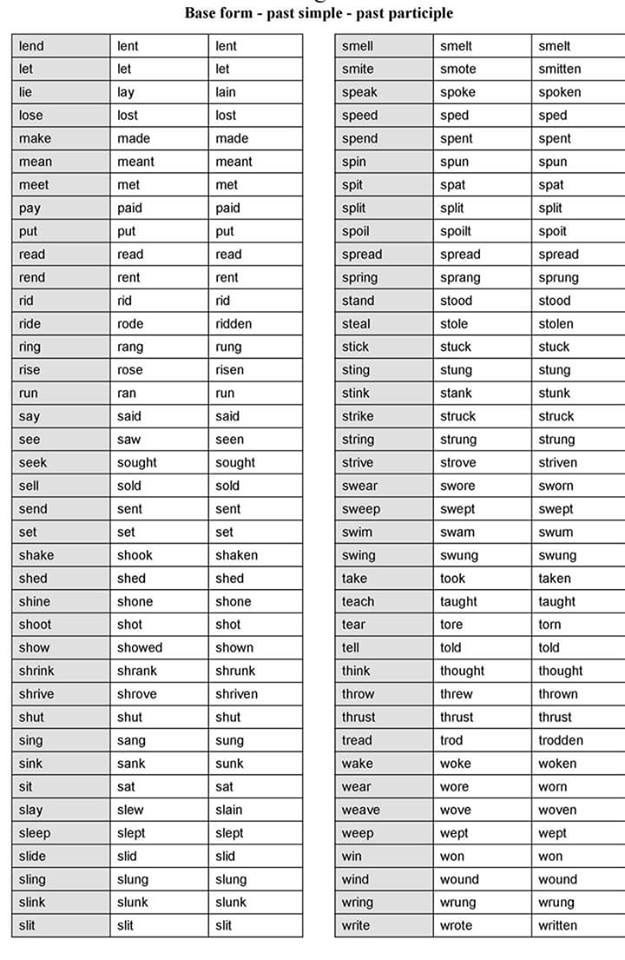
I have already written my English paper.I will write an English essay tomorrow.Here is a quick reminder for these verb forms: The following irregular verb tables are sorted according to V1,V2, and V3 forms. In any case, consult your dictionary if you are not sure about the exact usage. Moreover, there may also be finer nuances in meaning pertaining to the usage of the former or the latter. A general rule of thumb here is that the regular verb option (with ed, no vowel change) is more commonly used in American English, whereas the irregular option (vowel change) is still in use in British English. You may notice that in some verb parts there are two correct forms. Remember that for looking up irregulars verbs after you have learned them, you have an alphabetical list in any dictionary for easy referencing. You may consider creating flash cards with the different groups and study them, as explained on our vocabulary strategies pages. You could also read the table headings if it helps you, or simply focus on the verbs themselves. Read through the tables and make note of the verbs you find useful for your purposes. This kind of clustering aids your memory, which will strengthen with practice. Regardless of the linguistic distinctions and classifications, which tend to be too complicated for learners, we suggest that you use the following tables, clustering together irregular verbs with similar change patterns in small groups. A user-friendly way to study English irregular verbs: The classification of verbs to weak and strong in Modern English is less important for learners, so you can suffice with the regular-irregular distinction. In strong verbs the simple past and past participle are usually distinct, with the past participle having an en ending (speak-spoke-spoken). In weak verbs, the simple past and past participle forms are identical, bearing a d or t ending (buy-bought-bought). Still, the ten most used verbs in English are irregular.Īnother distinction is between weak and strong verbs. Irregular verbs originate mostly from Old English, while any new verb coined in later periods tends to be regular. Some irregular verbs do not change form at all (let-let-let).

However, there is a considerable number of irregular verbs (about 450, but only about 200 are in common use) that form their simple past and past participle forms with a vowel change, such as in see-saw-seen (see table below). But every word is a window into its colourful history, and some of the most interesting views are through our irregulars.Most verbs in English are regular verbs, meaning that they add the ed ending to form both the simple past and the past participle forms, which are identical, such as play-played-played. By the time native English speakers are adults, the strangeness of irregular verbs has faded through familiarity. In the last link, Beth says this idiosyncrasy is part of what makes the language beautiful, and I agree. And sometimes two past-tense forms are retained with slightly different uses, as with hanged and hung. Irregulars that are seldom used are more likely to eventually conform to the norm thrived, for example, is supplanting throve, which now sounds old-fashioned ditto chidedand chid. Over time, some irregular forms die off from disuse – or they survive only in regional dialects, which is where we find brung and holp alongside b rought and helped. The radical irregularity of be, with its was, were, is and are, results from an ancient merger between several Old English verbs, including bēon, eom and wesan. Go took its past-tense form went from that of the verb wend, as in “ wend your way”. They have been used often enough for long enough to resist being regularised. Most of the commonest English verbs, such as be, do, have, go and say, are irregular. You can test your knowledge of them using Macmillan’s Irregular Verb Wheel. Though obviously irregular, these forms follow eccentric sub-rules of their own within clusters of similar-sounding words. Snuck from sneak arose mysteriously around the same time, perhaps by analogy with stick-stuck and with a pinch of sound symbolism. Knelt from kneel appeared in the 19th century, apparently following the pattern of feel-felt and the related sleep-slept, meet-met, feed-fed and company.

New regulars predominate, but irregulars occasionally emerge. It was never going to be meerkot, meerkate, or anything other than meerkatted. In fact, an author did just that, writing “ meerkatted to attention” in a recent novel. So if we want to make a verb out of, say, meerkat, we just add -ed (and double the t). New verbs and whimsical verbings are almost always regular.


 0 kommentar(er)
0 kommentar(er)
